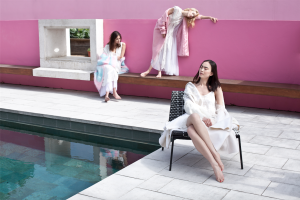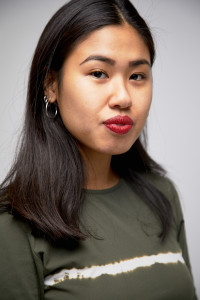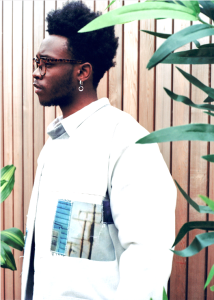Award-winning ‘Britnoy’ designer-stylist bats for ethnic inclusion
LONDON — At a cozy little café in Camden, I’m sitting across from Isabelle Landicho, an upcoming Filipino-British stylist and designer whose thought-provoking, individualistic and ethnically inclusive approach to fashion is adding new dimensions to the UK scene.
As a stylist, Landicho has worked on features for publications such as Otho, Vanity Teen, Kneon, Jute, Superior, Syn, Push it, Style Noir, BUMF and NIL.
She has further assisted on shoots for clients including MixMag, ASOS, Harrods Magazine, The Ingenue, Fantastics and Used.
Between sips of green tea, as we discuss her career and background, Landicho’s creative philosophy becomes strikingly clear: to create meaningful fashion and to blaze a path in the industry, borne from a place of ethnic representation and inclusion.
Her keen awareness of her own dual-culture identity as a Filipino immigrant in the UK informs every decision she makes, both in life and fashion.
Caught between cultures
Born in Manila, Landicho spent her childhood in the Philippines. Her mother hails from Cavite, her father from Batangas. When she was eight years old, Landicho’s family relocated to London.
Being part of two cultures and questioning her multicultural identity, informs every aspect of her creative process. In all her projects, Landicho pushes for ethnic representation in her models.
“It took me a while to come to terms with it, but my cultural identity is what sets me apart. I have embraced it and it is one of the biggest driving forces behind my work.”
“Coming from the Philippines to England, there were times growing up that I felt very low about my physical appearance,” Landicho reflects. Her words resonate. “A lot of my friends were white, and I was surrounded by people who looked different from me. The way I looked was different. I’d think, ‘Why don’t I look like that? Why don’t I have blonde hair, blue eyes?’”
“You don’t feel like you’re pretty enough. You don’t feel you’re good enough. So I think there’s a turning point now in society where more girls from different backgrounds are realizing that yes, they are good enough, and self-acceptance is now made so much more present in society earlier for girls.”
From illustration to fashion
Landicho always had an artistic background, taking up studies in illustration and graphic design, which led her naturally into fashion.
“I was an artistic child, always writing, reading and drawing,” recalls the stylist. “I started off illustrating and began a degree in graphic design and visual communications. But I always knew that I wanted to do fashion, so I switched my degree and chose fashion instead.”
After obtaining her Bachelor of Arts in fashion design and technology at the Arts University Bournemouth, the 24-year-old stylist went on to win the Stylist of Tomorrow Competition hosted by Harrods Magazine in 2015.
She was further shortlisted for the Graduate Fashion Week Styling and Creative Direction Award, and became a top 15 finalist in i-D Magazine’s Diversity Now: All Walks Beyond the Catwalk competition.
Landicho’s love for the arts remains one of her biggest influences: “I get a lot of my inspiration from photography, or art, or paintings. They make my fashion ideas richer.”
Creating meaningful fashion
Landicho’s graduate menswear collection, “Hey There! Kill Me Now!” recently made its catwalk debut at Moda de Pilipinas, London’s newest fashion showcase for South East Asian fashion designers.
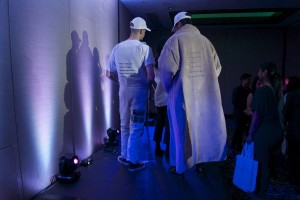
Isabelle Landicho’s Hey There! Kill Me Now! collection at Moda de Filipinas. INQUIRER/Melissa Alcantara
Inspired by millennial disenchantment, wasted suburbia and Harmony Korine’s cult movie “Gummo,” the playful collection sprang from Landicho’s emotional state at the time.
“I wanted to make something good out of the way I felt,” Landicho reflects. “I wrote the embroidery and poetry myself, it was kind of tongue-in-cheek. It’s meant to be humorous, you’re meant to identify with it. But at the same time it’s a bit nihilist. It’s based on destruction and romanticism.”
“It’s very raw, honest and came from the lowest place someone can be. Putting that into my fashion was a really good outlet.”
Although the designer sketched her ideas for a long time, she only learned how to properly sew during her fashion design pathway course.
Her materials and fabrics are sourced mainly from Shepherd’s Bush Market and Goldhawk Road.
Gender neutrality in fashion
Landicho specializes predominantly in creating menswear, she says, because the shapes are more interesting, and because she enjoys the simplicity of the cuts.
“As a person I have a very minimal aesthetic, as a stylist and designer too. A simpler silhouette, I think, is important. It makes more of an impact. Because the shapes are so simple, I can play around more with embroidery, fabrics, denim, heavyweight jersey. You have more freedom.”
She is quick to clarify, however, that although her designs are technically labeled “menswear,” they aren’t specifically geared towards men — on the contrary, she strongly advocates subverting gender stereotypes in fashion.
“My designs are gender-neutral,” says the young designer. “Wear whatever you want, whether you’re a girl or not. You’re entitled to look, feel and dress however you want to perceive yourself. Menswear seems more comfortable to me, generally. I’m not very ‘girly’ myself.”
Landicho’s gender-neutral approach to fashion filters out into her own clothing choices. For the unveiling of her debut collection at Moda de Pilipinas, she donned a barong tagalog — a typically male traditional shirt — for the occasion.
The clothing choice was a loaded statement.
“It was important for me to wear a barong tagalog because I wanted to celebrate Filipino tradition, yet subvert its patriarchal values by showcasing that women can wear men’s traditional clothing,” explains Landicho.
“As modern Filipino women we need to challenge gender stereotypes, but at the same time, not overlook our cultural roots.”
She recalls a time when she was a teenager, and was playing basketball in a park with her brother: “Some Filipino boys came up to us and invited my brother to play basketball with them. They ignored me. They didn’t even acknowledge me, just because I was a girl, even though I was playing too.”
“That’s when I realized that even in the Filipino community, gender stereotypes and relations were difficult. Women need to step up in the culture and show that our place isn’t in the kitchen. Yes, we’re raising children, yes, you need to support your husband and so on. But you’re still a woman. You’re still a feminist. There are roles in the Filipino household that they’re not happy with. I felt I wanted to represent that by wearing a barong at the show.”
Bringing identity and diversity to fashion design
Since being Filipino and British influences everything that Landicho creates, I ask if she’d ever consider working with more traditional textiles such as pineapple fibers.
“Definitely,” says Landicho. “I think for my second collection, I’ll focus on the environment and recycled fashion. But I also want to work more with the identity of a ‘Britnoy’ (British Pinoy).”
“I am an immigrant, and I am in this country. I want to see where that leads. I identify very much as both English and Filipino. I ask myself these questions a lot. You can’t have one without the other.”
Moving to a foreign land as a child, Landicho admits that coming to terms with her sense of identity can often be difficult.
“Growing up, it was hard. I think moving from the Philippines to the UK at such a young age really shapes you, because you become an outsider in those communities in both countries.”
“That sense of being an outsider is really important. You’re never really one or the other. You’re an accumulation of the people, or the things, surrounding you. I identify as both [English and Filipino].”
As a Filipina stylist breaking into fashion, Landicho considers her background as an asset.
“I have learned to love myself and love my culture. With that, I wouldn’t be the same without my culture. That feeds so much into my artwork, my styling, my design — especially my shoots, because I want to feature girls and boys that people can relate to.”
The shoot that helped Landicho win the Harrods Magazine competition was a shoot based on “The Virgin Suicides,” shot by Charlotte Ellis, featuring three multicultural models.
“I really pushed for the Asian model, because there’s such a lack of diversity in fashion. Literally in every project I do, I push for multi-ethnic models and talent, because it’s so important.”
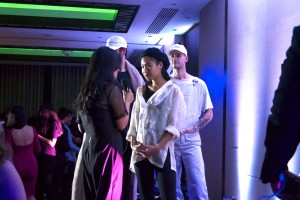
British-Filipina designer Isabelle Landicho being interviewed after a show. INQUIRER/Melissa Alcantara
“I want to keep pushing for that,” says Landicho. “I just want to have an Asian female figure in society that ‘normal’ girls can relate to.”
“I always speak to my models about this. I just think it’s so good to be representative in fashion. What’s the point if you can’t speak to people? It’s such a large medium, and it speaks to so many people, it needs to be representative of race, gender, culture — of people. Of everything.”
Embracing one’s roots
Landicho speaks about the Philippines often to her friends, as it’s a subject so close to her heart.
“I talk about the Philippines all the time. It’s really important to learn about different cultures, and to identify with and understand your own culture too. It’s crucial to educate people — not to lecture them or anything — but to educate them through food, through the quirks of the culture, and so on. For example, I took my boyfriend to see “Heneral Luna.” He really enjoyed himself — mainly because it was gory.”
“You need to have that sense of identity with your culture, you need to identify with your culture early on,” Landicho continues. “It really shapes you as a person, helps you makes sense of the world. Specifically, for Britnoys, they need to experience the ‘Filipino’ way of life — family, friends, everything. It’s important.”
“My identity shapes me. Who I am now is who I always have been. I’ve never felt so mindful and aware of myself and where I am right now. I’m Filipino and British. Everything I create comes from there.”
As our chat draws to a end, I ask Landicho if she has any parting advice to share for those who might be having similar struggles with their identity.
“Try your best, for anything and everything you do,” she says. “That’s my favorite philosophy.”
For more information, visit www.isabellelandicho.co.uk or @lethal_izzle on Instagram. – @melissalegarda

